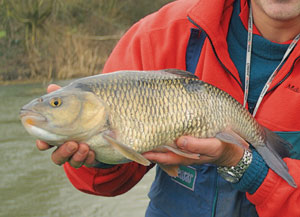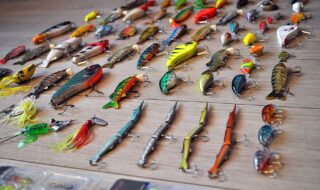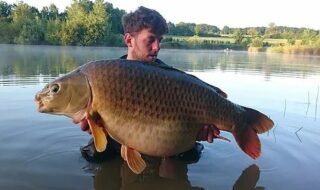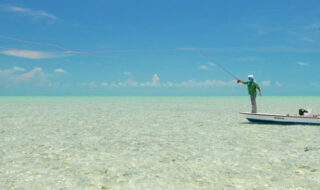Chub (also known as Chevin) (Leuciscus Cephalus)
Weight: Small chub are often mistaken for dace, but it’s easy to tell the difference, as the chub has a convex-shaped anal fin compared to the dace’s concave fin. The fish are veracious feeders and for the river angler will feed in the coldest conditions when all others are in a comatose state. As a river species a chub of 5lb was seen as a specimen, but with the introduction of high protein baits a fish of 6lb and even 7lb on some southern venues is achievable. Today you will also find big chub in stillwaters, especially in those close to rivers where the fish have migrated during times of flooding. The fish in these venues quickly grow big due to a rich food supply and little in the way of competition. The current British best was taken from a gravel pit
British Record: 9lb 5oz fish. Andy Maker from a stillwater in Gloucestershire in June 2007. In some parts of Europe they can grow much bigger than this
Length: Rarely exceeds 50cm, but some have reached 51cm
Age: Chub are slow growers and can live for up to 22 years in the wild
Preferred habitat: A shoaling fish, chub are most abundant in the middle reaches of most rivers in the UK, but are very much at home in the faster waters of trout streams and lowland reaches of bigger waterways. However, today more and more stillwaters now stocked with chub where they thrive and make a welcome addition to any venue’s mixed population, as they feed in all conditions
Feeding: Young fish feed on a natural diet of insects, their larvae and crustaceans. Chub are however predators and mature fish will eat small fish as well as crayfish, lamperns (river lamprey) and even on occasions, frogs and small water voles
Hybridisation: Is known to cross-breed with roach, rudd and possibly bream
Maturity: Males three to seven years and females four to eight years
Spawning: Between May and July where the sticky eggs are laid in the shallow water on clear gravel where they adhere to large stones and plants. The young hatch in eight to 10 days, depending on the water temperature that needs to be between 18 and 20 degrees Celsius.
Natural predators: Pike; perch; chub
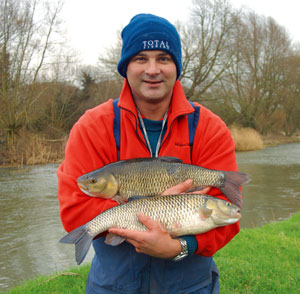 |
Identification
Colouring
Small fish are dark-backed with silvery flanks, but as the fish matures its back takes on a grey-brown or dark green colour and its flanks a pale, burnished gold that in some venues turns to a deep bronze.
Mouth
The chub has a thickset head and a blunt snout, but looks can deceive, as it has an extremely large mouth, white inside with tough, rubbery lips.
Eyes
They are a predator, and the chub’s eyes are a little larger than other silver fish, so they have very good vision. The large pupil is surrounded by a thin ring of gold colouring and a speckled iris.
Pectoral Fin
Convex in shape, these are watery orange-brown in colour, but in older fish they appear a lot darker.
Dorsal Fin
A dark, bluish-grey the fin is located just behind the base of the pelvic fins. It has eight to nine branched rays and is slightly convex in shape, although it looks almost straight-edged.
Pelvic Fin
These are also convex in shape with thick rays and are yellowish in colour, but on some venues these can turn a light orange.
Anal Fin
Used to identify the chub when compared to a dace, its conspicuously convex shape has seven to nine branched rays and is yellowish in colour, but can turn a deep orange at certain times of the year.
Tail/Caudal Fin
This large dark, bluish-grey forked-shaped paddle gives the chub its acceleration and strong fighting qualities. From above you can identify chub in the water as this fin appears to have a black outline.
The Lifecycle
Southern Native
You’ll know the chub by its broad head, big, white fleshy lips and rounded fins, the black margin of the tail making it recognisable in the water. It is now one of the classic river fish of much of England, living in moderately flowing reaches, often tucked up under overhanging bushes.
Originally native to the rivers of the southeast, especially the Thames catchment, the chub has been spread across much of England and parts of Wales and Scotland by anglers. Very recently, a specimen was found in an Irish river, so it seems it has moved there too.
Stillwater Record
However, chub are now found in many stillwaters, either stocked into commercial fisheries to boost winter sport and add variety, or possibly washed into gravel pits close to rivers. There are also plenty of canals holding big heads of chub. In gravel pits, the fish can grow massive, as Matt Micalleff’s claimed British record of over 9lb from a lake near Oxford shows.
Life’s Beginnings
Chub start life in the spring when water temperatures rise above about 12ºC. The females laying sticky eggs that cling to gravel, rocks and weeds. Absolutely miniscule, eye-lash-size fry hatch out after a week, tumbling downstream in the flow, hopefully to find quieter, slack water where they can settle and begin to feed.
Growth of the young fish is slow, reaching perhaps 4cm after one year, 15cm after three years and maybe 30cm after 10 years.
Spawning Time
Chub start to spawn at three to five years of age, females producing between 25,000-100,000 eggs, depending on their size.
You might be able to recognise a male fish at the end of a fishing season (or early in the next season) because in the spring and early summer they grow small, white pimples called spawning tubercles on their heads, which apparently the females find attractive!
Long Livers
Chub can live for a very long time, perhaps over 25 years, though 15 years is probably more normal.
By this age, we could be talking about the really big 6lb-plus fish with a maximum size in Britain thought to be about 10lb. I once saw what was claimed to be a stuffed chub of 13lb and it could be true. In Europe, the fish grows to over 18lb.
Flood Years
Chub populations are greatly affected by river conditions. Rainy spring times producing flooding rivers can mean that hatching baby chub never find slack water and are washed away to their death. Warm, dry springs, producing low flows can mean that lots of young chub survive.
In several years time, after the chub have grown up, this good year class of survivors might produce great fishing.
This tends to make chub populations very unbalanced with lots of fish from the years when spring flows are low and few fish from spring-time flood years. A few bad years one after another can make fishing really tough and clubs often then look to stock farmed fish, but probably the best thing to do is to try to accept the natural variations in the river.
Monsters
The positive spin-off of the bad years is that the chub that do survive might just grow really big without competition from their brothers and sisters! It could be that the massive chub of the southern gravel pits have washed in from a flooded river and live long, settled lives, growing fat on a healthy, largely fish diet.
Nobody knows for sure if chub successfully spawn in stillwaters, although they might do so if they find natural springs upwelling through the lakebed.
Natural Food
When they’re tiny, chub eat minute bloodworms, water fleas, mayfly nymphs and some waterweeds.
As they grow, they take ever-larger water bugs, insects blown onto the water, quite a lot of weed, small fish and crayfish.
In really big chub, up to 30% of their diet could be other fish (including eels) and some chub stomachs have even been found to contain water birds! In the 17th Century, grasshoppers fished on the top were regarded as the best bait for chub.
Hybridisation
Quite rarely, chub hybridise with other fish such as roach, rudd and bleak producing fish that look a little like each of the parents, so keep an eye out for an odd-looking chub that could just be a mixture of species.
The editor once witnessed a 5lb rudd:chub hybrid at Rutland Water, which he describes as one of the most magnificent looking fish he’s ever seen.


